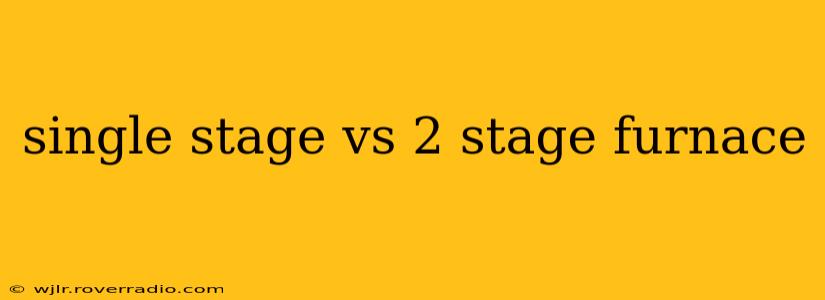Choosing the right furnace is crucial for your home's comfort and energy efficiency. A key decision often involves selecting between a single-stage and a two-stage furnace. Both effectively heat your home, but their operational differences significantly impact energy consumption, comfort levels, and long-term costs. This comprehensive guide will explore the nuances of each system, helping you make an informed decision.
What is a Single-Stage Furnace?
A single-stage furnace operates on a simple on/off principle. It either runs at full capacity or is completely off. Think of it like a light switch: either on or off, no in-between. When the thermostat calls for heat, the blower and burner ignite at maximum power until the desired temperature is reached. Then, the system shuts off entirely until the temperature drops again.
Advantages of Single-Stage Furnaces:
- Lower initial cost: Single-stage furnaces are generally less expensive to purchase and install than two-stage models.
- Simplicity: Their straightforward design translates to simpler maintenance and fewer potential points of failure.
Disadvantages of Single-Stage Furnaces:
- Temperature fluctuations: The on/off cycling can lead to noticeable temperature swings, resulting in discomfort. The system cycles between blasting hot air and no air at all.
- Higher energy consumption: Constant cycling between full power and off wastes energy, leading to higher utility bills compared to two-stage systems.
- Shorter lifespan: The constant strain of operating at full capacity can reduce the lifespan of the furnace components.
What is a Two-Stage Furnace?
A two-stage furnace offers a more refined approach to heating. It operates at two different capacity levels: a low-stage and a high-stage. The low-stage setting provides a gentle, consistent warmth, ideal for maintaining comfortable temperatures on milder days or during periods of less intense heat demand. When more heat is needed, the system switches to high-stage for maximum output.
Advantages of Two-Stage Furnaces:
- Improved comfort: The gradual heating and consistent temperature maintenance minimize those uncomfortable temperature swings associated with single-stage units.
- Greater energy efficiency: By operating more often at a lower capacity, two-stage furnaces conserve energy and reduce utility bills. The low-stage setting can maintain comfort levels even in mild weather conditions, reducing the need for full-power operation.
- Longer lifespan: Reduced strain on components translates to potentially longer system lifespan.
- Better air filtration: Some two-stage furnaces incorporate better air filtration systems, improving indoor air quality.
Disadvantages of Two-Stage Furnaces:
- Higher initial cost: The more complex design and added features result in higher purchase and installation prices.
- Slightly more complex maintenance: While not overly complicated, two-stage furnaces may require slightly more specialized maintenance compared to single-stage models.
Which Type of Furnace is Best for My Home?
The ideal choice depends on several factors, including:
- Climate: In areas with harsh winters, a two-stage system’s efficiency and comfort benefits are more pronounced. In milder climates, the energy savings may be less substantial.
- Budget: Single-stage furnaces offer a more budget-friendly upfront cost.
- Home size and insulation: Larger, poorly insulated homes will benefit more from a two-stage furnace's ability to maintain consistent temperatures.
- Comfort preferences: If consistent, even heating is a priority, a two-stage system is generally preferred.
How Long Do Furnaces Last?
The lifespan of both single-stage and two-stage furnaces can vary greatly depending on factors like maintenance, usage, and the quality of the unit. However, generally, a well-maintained furnace can last anywhere from 15 to 20 years. Regular maintenance significantly impacts longevity.
What are the Common Furnace Problems?
Common problems can arise with both types of furnaces. These include issues with the ignition system, blower motor, heat exchanger, and various other components. Regular professional maintenance can help detect and resolve potential issues before they escalate into major repairs.
How Much Does a Furnace Cost?
The cost of a furnace varies widely depending on factors such as size, efficiency rating, brand, features (like two-stage operation), and labor costs for installation. It's best to obtain quotes from multiple HVAC professionals for accurate pricing in your area.
Ultimately, the decision between a single-stage and a two-stage furnace requires a careful consideration of your individual needs, budget, and climate. Consulting with a qualified HVAC professional is highly recommended to assess your specific situation and determine the optimal solution for your home's heating requirements.
